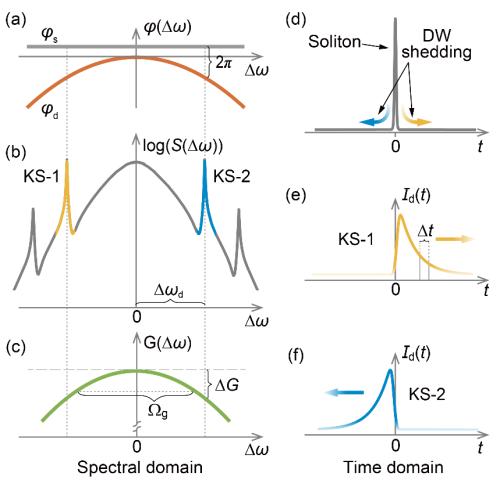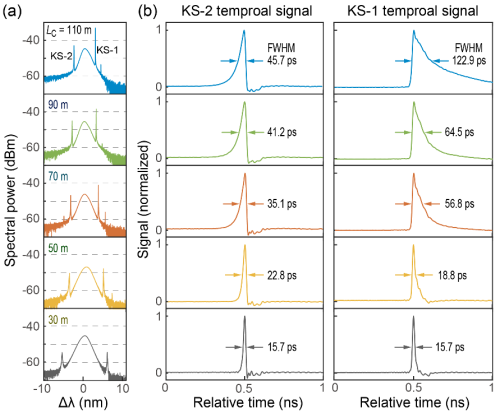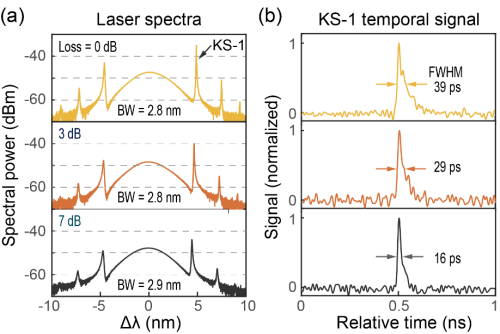The State Key Laboratory of High Field Laser Physics and the Innovation Center for the Integration of New Laser Technology of the Shanghai Institute of Optics and Fine Mechanics, Chinese Academy of Sciences has made progress in the research of soliton mode-locked fiber lasers. The research team reported the physical mechanism of dispersive wave radiation in mode-locked fiber lasers and its time-domain characterization. The research results were published in the IEEE Journal of Lightwave Technology on March 25, 2023 under the title “Characterization and Manipulation of Temporal Structures of Dispersive Waves in a Soliton Fiber Laser”.
The dispersive wave,which is known as Kelly sideband in the frequency domain is generated from the soliton, and was first discovered and explained by S. M. Kelly in 1992. It is produced by the periodic amplification and attenuation of the soliton pulse during its propagation in the laser cavity, and is reflected as a series of sidebands symmetrically distributed in the two side of central wavelength in the soliton spectrum. The dispersive wave shed by the soliton is in turn closely related to the soliton’s stability. In mode-locked fiber lasers, the generation of Kelly sidebands is an important factor causing the limitation of the soliton energy level, thus often needs to be suppressed by some technical methods. On the other hand, the dispersive wave can also become a medium for long-distance interaction between solitons, affecting the stability of the soliton pair.
Previously, most experimental studies on dispersive waves in soliton lasers focus on the study of their frequency-domain structures (i.e., Kelly sidebands), while research on the temporal structure of dispersive waves is still absent, and there is no simple theoretical explanation and experimental study of the effects of different laser parameters on the temporal structure of dispersive waves.
In order to solve this problem, the research team established a dynamic picture of the temporal structure of dispersive waves in soliton fiber lasers to analyze two important factors: one is the variation in phase-matching condition caused by the group velocity delay inside the cavity, and the other is the gain-filtering effect inside the cavity. Thus they derived the time profile of the dispersive wave with a bilateral exponential decay form. In the experimental study, the research team built a unidirectional ring mode-locked fiber laser and measured the time-frequency signals of dispersive waves under different cavity parameters by controlling the cavity dispersion and loss.
Then they realized the manipulation and measurement of the time-frequency waveform of the dispersion wave to a certain extent. The experimental results are consistent with the predictions of the theoretical model. In addition, the team also studied the response time delay of dispersive waves and solitons, and the symmetry of dispersive wave structures. This study can deepen the understanding of the dynamic process of soliton fiber lasers, and also provide a certain reference for the development of application technologies such as ultrafast fiber lasers and optical soliton information processing.
Through theoretical and experimental studies, the research team demonstrated the temporal characteristics and mechanism of dispersive waves, and achieved effective manipulation of the temporal structure of dispersive waves. This research on the temporal characteristics of dispersive waves not only enriched the soliton dynamics theory in mode-locked lasers, but also provides technical hints for applications such as ultrafast fiber lasers and optical soliton information processing.

Fig 1.The generation principle of dispersive wave. (Image by SIOM)

Fig 2.The effect of cavity group delay. (Image by SIOM)

Fig 3.The effect of cavity loss. (Image by SIOM)
Article website:
https://doi.org/10.1109/JLT.2022.3224564
Contact:
WU Xiufeng
General Administrative Office
Shanghai Institute of Optics and Fine Mechanics, CAS
Email: xfwu@siom.ac.cn
Web: http://english.siom.cas.cn/